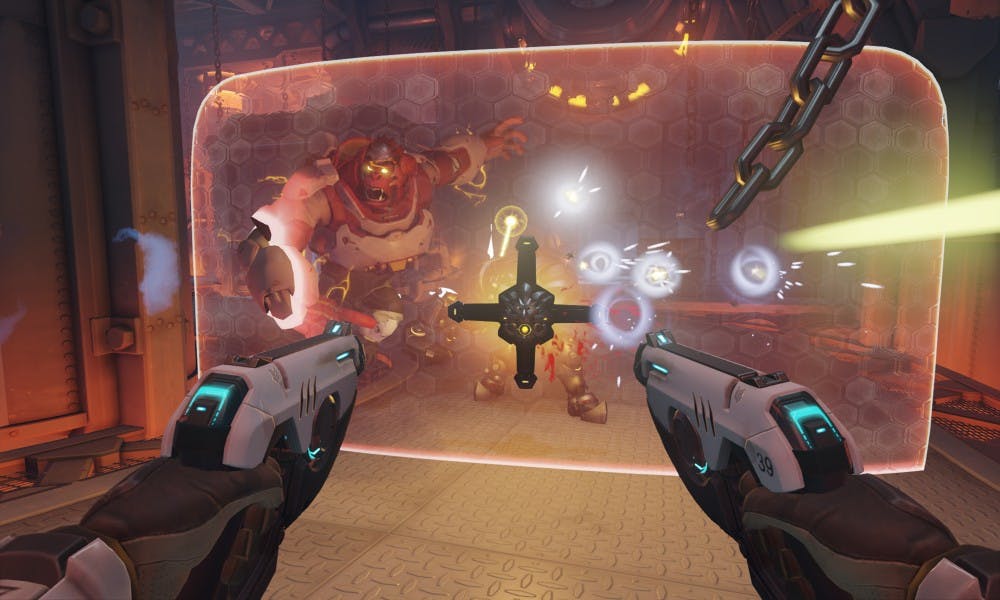From the moment I first saw footage of “Overwatch,” I was deeply interested because of the game’s colorful world and charming characters. The only problem was the fact that the game has a multiplayer first-person shooter structure, a genre that I usually don’t enjoy because of its repetitive gameplay and my lack of skill with the genre.
I kept telling myself that I wouldn’t enjoy “Overwatch” and that, on my college budget, it wouldn’t be worth the $60 it would cost. However, after constantly seeing gameplay videos, hearing internet personalities praise it and having my friends beg me to buy it, I finally broke down and got the game. I was far from disappointed.
In “Overwatch,” players are put into teams of six and have to either attack or defend points or escort payloads to certain locations depending on the game mode. “Overwatch” is not a typical online shooter game in many ways — the most prominent of which is the variety of characters and play styles it offers.
The game has 21 playable characters that fall into four roles: Offense, defense, tank and support. Each role has its own contribution to the battle, and each character within the roles also has highly unique individual abilities.
In many games with a roster of characters, players find their one or two characters they are good with and focus most of their attention on them. In “Overwatch,” however, players are meant to strategize their character choices based on what their allies and foes have chosen. This method gives this game a unique way for players to win and makes it more fun.
Each match in “Overwatch” is six-versus-six, and how each side builds their team is crucial to their chances of success. For example, a team that is overloaded with offensive players and has no support or tank players will likely be at a disadvantage going against a more balanced team with offensive players at the front lines, defensive players building shields around them and support players healing them from behind.
Because of this, everyone participating in the game feels important. Even if you are someone like me who isn’t the best shot with a gun, you can play a support class and lead your team to victory by keeping your team’s powerful players alive.
Each character in “Overwatch” has different abilities and an ultimate attack that they build up to by getting kills, doing damage and healing allies. Every character’s ultimate attack is vastly different, with some being offensive — like D.Va’s, where the character makes her mech suit self-destruct, killing those around her — and some being defensive — like Mercy’s, where she brings nearby allies back to life.
Learning how and when to use each character's abilities is highly satisfying, and after more than 20 hours with the game, I was still finding new ways to use different abilities. What is most important about these powers is that they are balanced, meaning that someone can’t give themselves an advantage by selecting a certain character as long as the opponent knows how to counter them.
In addition to balanced and engaging gameplay, “Overwatch” is also overflowing with charm and personality. Each character has his or her own catch phrases, and they occasionally have conversations with one another about their past experiences. The characters are often funny. Each character also has multiple victory poses and character-select screen poses that say a great deal about their personality and backstory in a subtle way.
Art style is another way that “Overwatch” stands apart from its competition. In a genre filled with games such as “Call of Duty” and “Halo” that use very muted colors to add realism, “Overwatch” takes a risk by using heavily saturated and bright colors to create a more stylized and colorful aesthetic. The result is a game with its own refreshing look and a lighthearted and fun tone that makes it hard not to fall in love with "Overwatch."
Every map in the game takes place in a different country and is made with a keen attention to detail that bring the player maps, such as the Hollywood map that contains different movie set pieces and the Japanese map filled with cherry blossoms.
“Overwatch” also has a fairly satisfying progression system where, in each match, players gain experience towards their overall level. Each time the player levels up, he or she receives a loot box. Loot boxes give the player random prizes such as a new skin for a heroe, a voice line, a victory pose or in-game currency that can be used to buy certain skins, voice lines, etc. The money grind is very slow and there is the chance of getting duplicate loot or receiving something for a character you don’t like, but overall the loot boxes are a simple and fun reward for putting time into the game.
“Overwatch” certainly doesn’t lack in quality — however, it does lack somewhat in quantity. Currently, there are only four game modes, and one of them is a hybrid between two of the other modes. There are 12 maps, but it doesn’t take long before you start to see the same maps over and over.
The good news is that Blizzard has said that it will be supporting the game with free downloadable content, which means that the game's slight lack of content might be fixed in the future, and it might also be free of cost.
Overall, “Overwatch” is an immensely fun game that defies the traditional characteristics of a multiplayer first-person shooter, and it allows players to build and show their skills in creative and diverse ways. Whether you are a pro at online shooters or someone who normally avoids the genre, this is a game you need to try.

